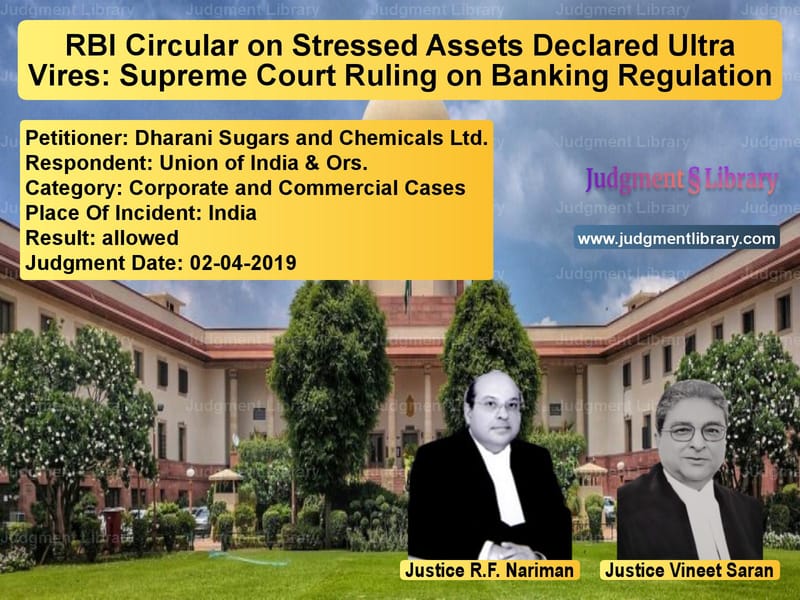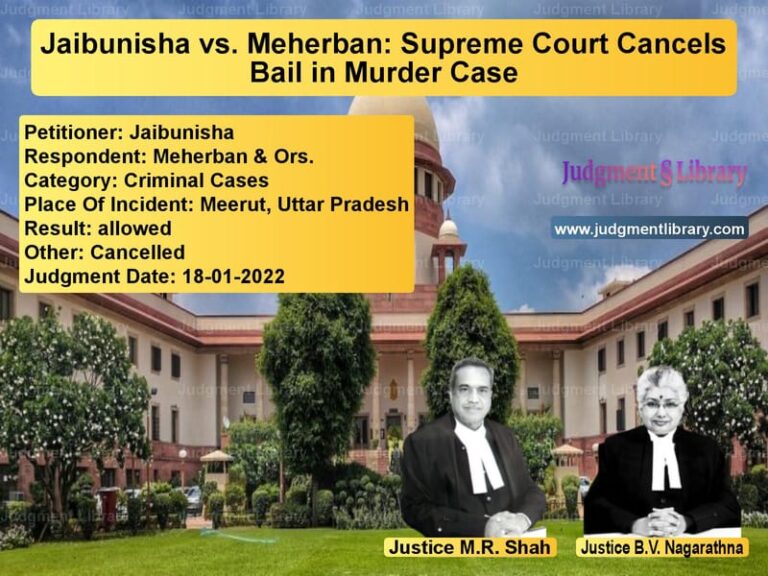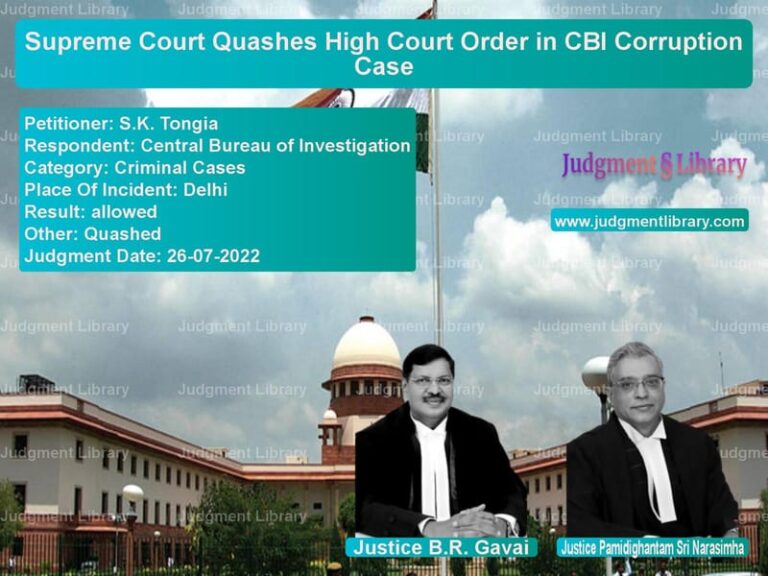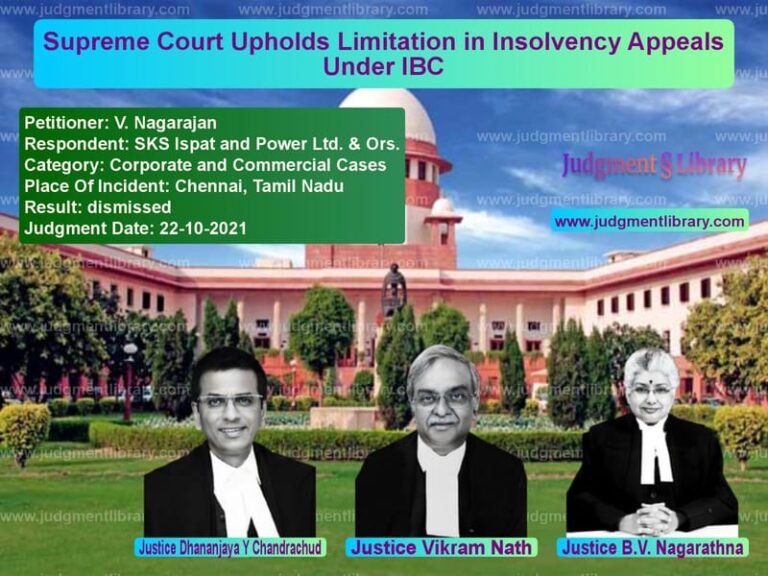RBI Circular on Stressed Assets Declared Ultra Vires: Supreme Court Ruling on Banking Regulation
The Supreme Court of India, in its landmark judgment dated April 2, 2019, declared the Reserve Bank of India’s (RBI) circular on the resolution of stressed assets as ultra vires. The case involved multiple petitions, led by Dharani Sugars and Chemicals Ltd., challenging the constitutional validity of Sections 35AA and 35AB of the Banking Regulation Act, 1949, as well as the RBI circular issued on February 12, 2018.
Background of the Case
The case revolved around the RBI’s 2018 circular, which introduced a revised framework for resolving stressed assets. The circular mandated that lenders initiate insolvency proceedings under the Insolvency and Bankruptcy Code (IBC) if a default continued for more than 180 days in accounts with an exposure of Rs. 2,000 crores or more. Several companies across different sectors, including power, telecom, and steel, challenged the circular, arguing that it imposed an arbitrary deadline and did not consider sector-specific challenges.
Key Issues Before the Supreme Court
The Supreme Court examined two critical legal issues:
- Whether the RBI had the authority under the Banking Regulation Act to issue the February 12, 2018, circular.
- Whether the circular violated Article 14 of the Constitution by treating all industries in a uniform manner without considering sector-specific difficulties.
Petitioners’ Arguments
The petitioners, represented by senior advocates including Dr. Abhishek Manu Singhvi, contended that:
- The RBI’s circular adopted a “one-size-fits-all” approach, failing to recognize the unique financial and regulatory conditions affecting industries such as power and telecom.
- The circular was unconstitutional as it was issued without prior authorization from the Central Government, violating Section 35AA of the Banking Regulation Act.
- The circular ignored recommendations from the Parliamentary Standing Committee and the High-Level Empowered Committee, which had suggested sector-specific measures.
- The 180-day resolution period was impractical and could force economically viable companies into insolvency.
- The requirement for 100% lender approval before restructuring debt was unfeasible, leading to delays and potential value destruction.
Respondents’ Arguments
The RBI, represented by Senior Advocate Rakesh Dwivedi, defended the circular on the following grounds:
- The RBI has statutory powers under Sections 21, 35A, 35AA, and 35AB of the Banking Regulation Act to regulate banking policies, including stressed asset resolution.
- The circular aimed to bring discipline in the financial sector and prevent the evergreening of bad loans.
- The deadline of 180 days was necessary to push banks towards a time-bound resolution mechanism.
- The economic rationale behind the circular was to ensure that non-performing assets (NPAs) were dealt with systematically.
Supreme Court’s Observations
The Supreme Court, in its judgment authored by Justice R.F. Nariman, made the following key observations:
- RBI Overstepped Its Authority: The Court ruled that the RBI did not have the power to issue such a circular without explicit authorization from the Central Government under Section 35AA of the Banking Regulation Act.
- Sector-Specific Approach Needed: The Court noted that treating all industries similarly, regardless of their challenges, violated Article 14 of the Constitution.
- Non-Application of Judicial Mind: The Court criticized the RBI for not considering various sector-specific Parliamentary Committee reports and expert recommendations.
- Violation of Banking Regulation Act: The judgment highlighted that Section 35AA allows the RBI to direct banks to initiate insolvency proceedings only for specific cases, not through a general circular affecting all defaulters above Rs. 2,000 crore.
- Retrospective Impact: The Court held that all actions taken under the February 12, 2018, circular, including insolvency proceedings initiated against companies, were nullified.
Final Judgment
The Supreme Court set aside the RBI circular and ruled:
“The impugned circular is ultra vires Section 35AA of the Banking Regulation Act and is, therefore, of no effect in law. Consequently, all actions taken under the said circular, including proceedings initiated under the Insolvency and Bankruptcy Code, are declared non-est.”
The Court directed that the RBI must obtain prior authorization from the Central Government before issuing similar directions in the future.
Impact of the Judgment
The ruling has several major implications:
- Relief for Stressed Companies: The judgment nullified all insolvency proceedings initiated solely on the basis of the RBI circular.
- Sector-Specific Solutions: The RBI and the government must now devise sector-wise strategies rather than implementing uniform regulations.
- Limited RBI Powers: The decision reinforced that RBI’s authority is subject to Central Government oversight under Section 35AA.
- Future Policy Changes: The government may need to introduce new regulatory measures to address NPAs, considering sector-specific economic conditions.
Conclusion
The Supreme Court’s judgment in Dharani Sugars and Chemicals Ltd. vs. Union of India is a landmark decision in banking regulation and financial law. By striking down the RBI’s circular, the Court reinforced the importance of due process and sector-specific policymaking. The ruling also clarified the extent of RBI’s powers under the Banking Regulation Act, ensuring that future interventions are carried out within constitutional and statutory limits.
Petitioner Name: Dharani Sugars and Chemicals Ltd..Respondent Name: Union of India & Ors..Judgment By: Justice R.F. Nariman, Justice Vineet Saran.Place Of Incident: India.Judgment Date: 02-04-2019.
Don’t miss out on the full details! Download the complete judgment in PDF format below and gain valuable insights instantly!
Download Judgment: Dharani Sugars and C vs Union of India & Ors Supreme Court of India Judgment Dated 02-04-2019.pdf
Direct Downlaod Judgment: Direct downlaod this Judgment
See all petitions in Bankruptcy and Insolvency
See all petitions in Corporate Governance
See all petitions in unfair trade practices
See all petitions in Judgment by Rohinton Fali Nariman
See all petitions in Judgment by Vineet Saran
See all petitions in allowed
See all petitions in supreme court of India judgments April 2019
See all petitions in 2019 judgments
See all posts in Corporate and Commercial Cases Category
See all allowed petitions in Corporate and Commercial Cases Category
See all Dismissed petitions in Corporate and Commercial Cases Category
See all partially allowed petitions in Corporate and Commercial Cases Category







